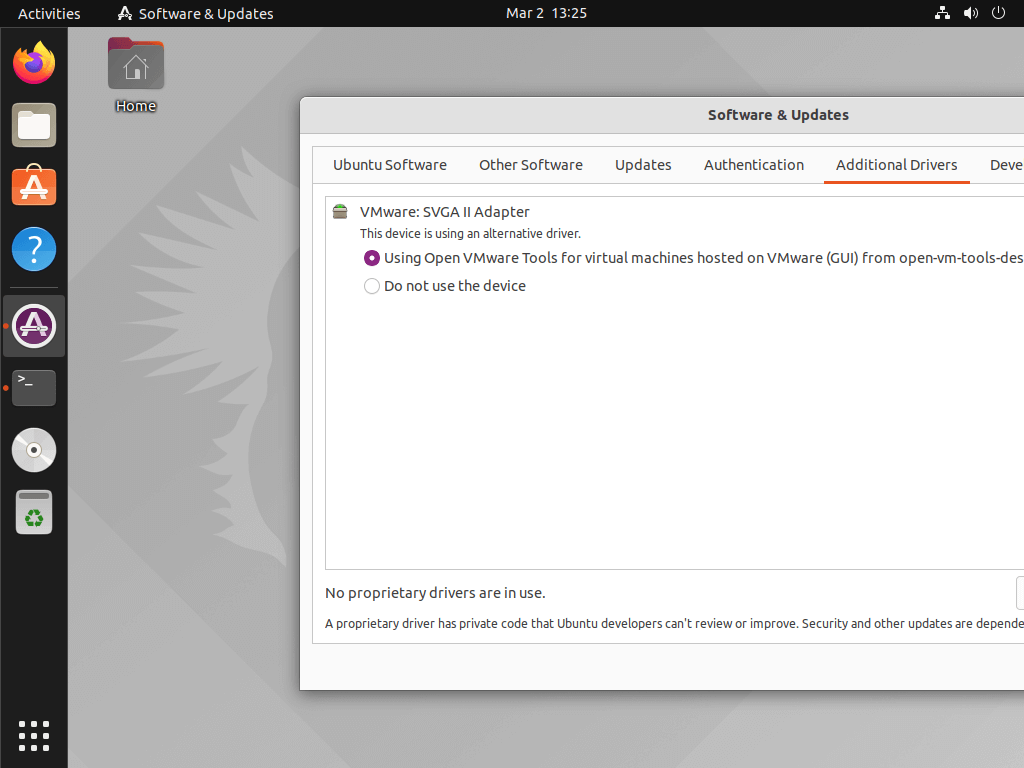
- #Install proprietary drivers ubuntu install
- #Install proprietary drivers ubuntu drivers
- #Install proprietary drivers ubuntu upgrade
- #Install proprietary drivers ubuntu software
#Install proprietary drivers ubuntu install
If you install a graphics driver from the default Ubuntu repositories, you will also get automatic updates for that driver which are sometimes linked to kernel updates.
#Install proprietary drivers ubuntu drivers
Don't worry about this, because if the difference between version numbers of the two proprietary graphics drivers is small, then you will get similar performance by using either of the two drivers. If you visit the official AMD or NVIDIA websites you will often see that the latest version of the proprietary graphics driver for your GPU is a little bit more up-to-date than the version of the same graphics driver that is available from the default Ubuntu repositories. If your computer has an Intel processor and it doesn't have a discrete graphics processor, the command ubuntu-drivers devices will not return results that show that a proprietary graphics card driver is available to be installed because the Intel graphics driver is built-in in Ubuntu. The devices command of ubuntu-drivers lists proprietary drivers that are compatible with your computer's GPU.
#Install proprietary drivers ubuntu upgrade
For most users there's no reason to guess about which proprietary graphics driver to install, because if your system deserves a graphics driver upgrade it will get one. Sometimes sudo apt upgrade even upgrades the proprietary graphics driver packages to more recent packages, in which case sudo apt autoremove removes the older packages which were replaced by the newer ones. In Ubuntu 20.04 and later running sudo apt upgrade not only upgrades the versions of the proprietary graphics drivers that were installed by sudo ubuntu-drivers autoinstall. The autoinstall command of ubuntu-drivers installs drivers that are appropriate for automatic installation including their dependencies. Open the terminal and type: sudo ubuntu-drivers autoinstall Now, for basic work, the open source Nouveau drivers work just fine. I have checked and thats correct there is no path by those names, so whats the problem? i dont want it uninstalling anything i want it installing FGLRXĪll i want is to install catalyst 11.9 drivers so I can run Gnome Shell 3 as was intended, please all help would be appreciated and apologies if I have missed anything out or seem to have misunderstood anything.Īlso here is my Laptop Setup in case this helps in any way:ĪMD Athlon II X2 Processor P320 (2.Ubuntu has a built-in ubuntu-drivers program that can decide automatically which graphics driver to install, and streamlines the installation of Nvidia drivers. Installation of proprietary NVIDIA drivers on Ubuntu 14.04.1 I recently built a brand new PC which was awesome with an i5-4690k, 8GB RAM, and a EVGA GeForce GTX 750 Ti GPU. Re-run /usr/share/ati/fglrx-uninstall.sh (this is not recommended).

Uninstallation files are located, set the force option To force uninstallation of the driver by guessing where the Required for determining where installed files are located. Or the current AMD driver installed is an older version than the Is not installed, the AMD driver is only partially installed, In over a decade of linux USER (NON-Technical) experience only once experienced a driver problem, that when I installed a proprietary driver once uninstalled, system reverted to linux driver, and everything worked fine :- ).

Uninstall : inst_path_default or inst_path_overrideĭoes not exist in /etc/ati. Various proprietary drivers rarely needed, most linux system drivers appear mostly to work fine. Currently, NVIDIA 510 Drivers are available to install, which bring many new features improvements to the very latest and existing supported graphic cards with better.
#Install proprietary drivers ubuntu software
usr/share/ati/fglrx-uninstall.sh: 32: cannot create /etc/ati/fglrx-uninstall.log: Directory nonexistent Historically, the Nouveau drivers are slower than NVIDIA’s proprietary drivers, lacking the latest graphics card hardware’s latest features, software technology, and support.


 0 kommentar(er)
0 kommentar(er)
